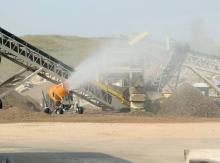Workers are put at risk every year due to exposure to harmful workplace dust, according to a new study from the University of Stirling, Scotland.
According to Profs Rory O'Neill and Andrew Watterson of the University of Stirling's Occupational and Environmental Health and Safety Research Group, crystalline silica is second only to asbestos as a cause of occupational cancer deaths.
Currently, a workplace exposure limit of 0.1 milligrams per m³ is set in the US and the UK under health and safety law.
American regulator OSHA has argued in favour of cutting it by half, as it is based on research dating back to 1968.
The Stirling University academics want the British safety regulator to follow suit and tighten standards, but the British regulator (HSE) is opposed to the move due to technological limitations in monitoring silica levels that precisely.
In an interview with UK-based hazards magazine Prof O'Neill said, "Modern science can obtain and analyse dust on Mars.
"If HSE's science can't obtain and analyse adequately one of the most commonly encountered and deadly workplace dust exposures here on Earth, who on Earth they are protecting?"
In the same interview, Prof Watterson added, “OSHA says a tighter standard is perfectly possible, can be monitored in the workplace and would save hundreds of lives and billions of dollars each year. Canadian provinces already monitor and enforce a tighter standard still."
A spokeswoman for the UK’s
"The advice HSE has received indicates that it is not practical or achievable to consistently and reliably measure real workplace samples of respirable crystalline silica to significantly lower levels.
"This is because the technical samplers currently used suffer from interference and poor precision at these low measurement masses.
"Measurement below the current workplace exposure limit would require complex sampling and analysis processes which have not been validated."






